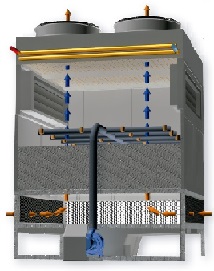What is adiabatic refrigeration?
Adiabatic cooling uses a simple thermodynamic principle. It takes advantage of the natural tendency of air to capture moisture, through a humidification system. In this way a decrease in air temperature is achieved. At the same time its relative humidity is increased and a cooler air stream is obtained than that of the inlet (dry air).
Adiabatic cooling operation
An adiabatic cooling system can lower air temperature between 2 ºC and 10 ºC. Therefore, in an adiabatic condenser the subsequent cooling of the coil is much more efficient.
Some adiabatic equipment can be used to cool water / glycol mixtures or condense refrigerant gases.
The temperature that can be reached is called “adiabatic saturation temperature.” This can be much lower than the temperature of the “dry” air depending on the efficiency of the humidification system.
Based on this principle, adiabatic refrigeration equipment, whether refrigerators or condensers, are recommended to increase the efficiency of air cooling systems.
By having a minimum water supply, they are especially indicated in cases where it is necessary to reduce water consumption or minimize the risks of water management
Electric consumption in adiabatic refrigeration
Adiabatic cooling not only saves water. The electricity consumption, compared to other cooling systems, is also reduced since, starting from an air current where we have lowered the temperature, we will need less of it for cooling. With this, the fans that move the air will need less consumption.
These air cooling systems maximize the characteristics of the fan in terms of flow, along with a very high humidification efficiency.
Factors that determine the choice of an adiabatic refrigeration system

a) relative air humidity
It is the most determining factor, since the smaller this is, the greater the cooling capacity of the system. So you will get better performance in the summer months and dry climates.
b) water temperature.
c) humidification system efficiency
Applications of adiabatic refrigeration
- Cooling / air conditioning systems, with low humidity levels during the warm months.
- Applications where refrigerant fluid temperatures need to be lowered below room temperature
Advantages of adiabatic refrigeration systems
- minimum maintenance
- water saving, compared to evaporative solutions
- low power consumption
- no risk of legionella (no sprays)
Condensers and refrigerators provide the principle of adiabatic cooling to improve the efficiency of finned coils. They can be used to cool water / glycol mixtures or condense refrigerant gases.
MITA Group has developed an air cooling system that maximizes fan characteristics in terms of flow, along with very high humidification efficiency.